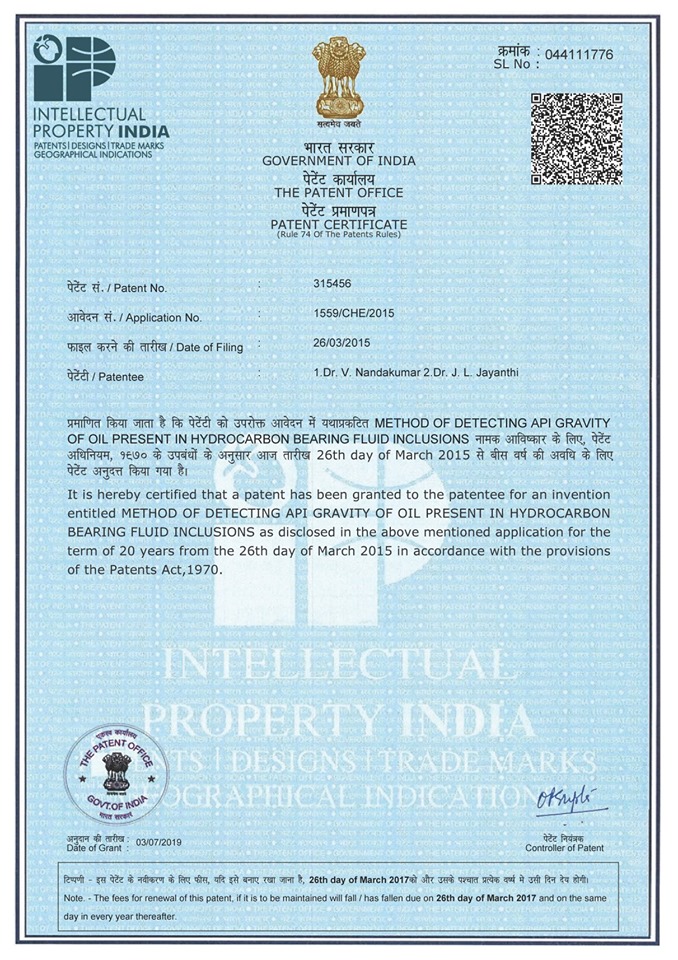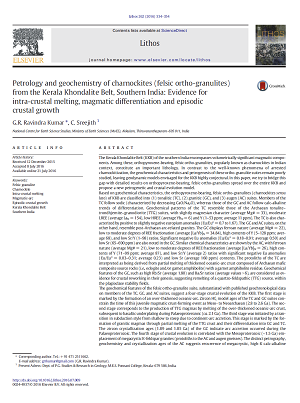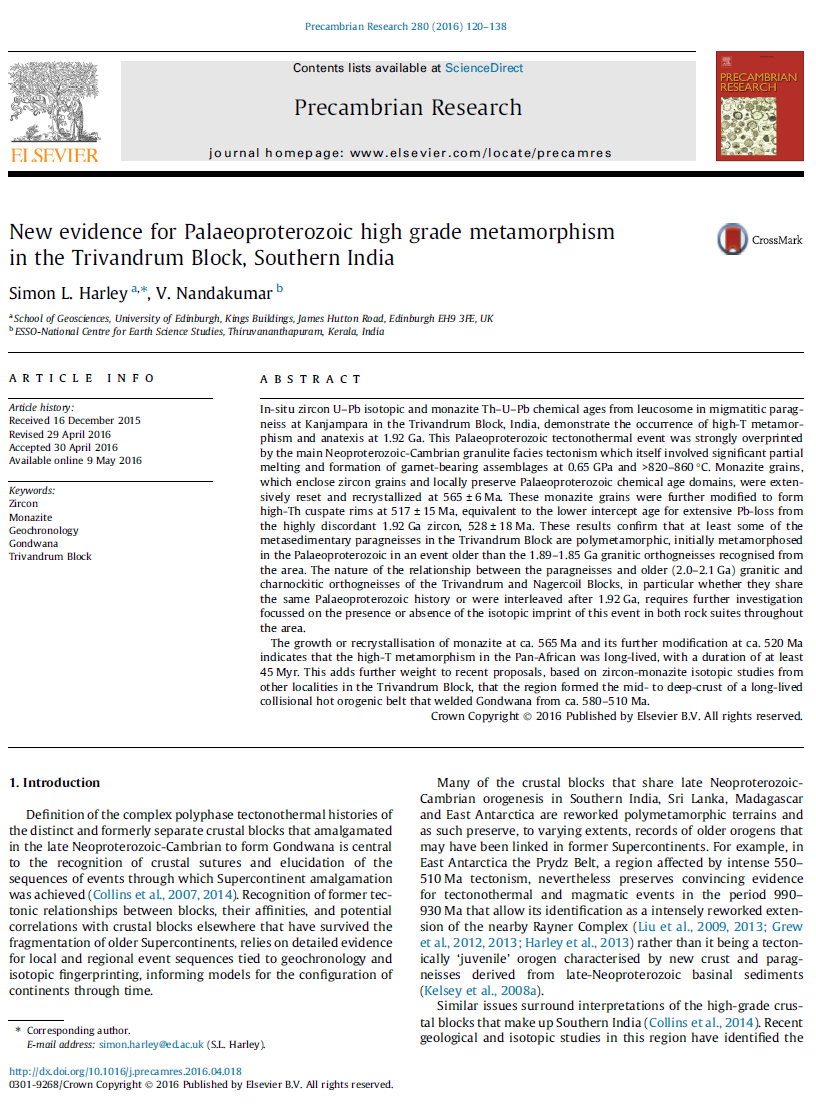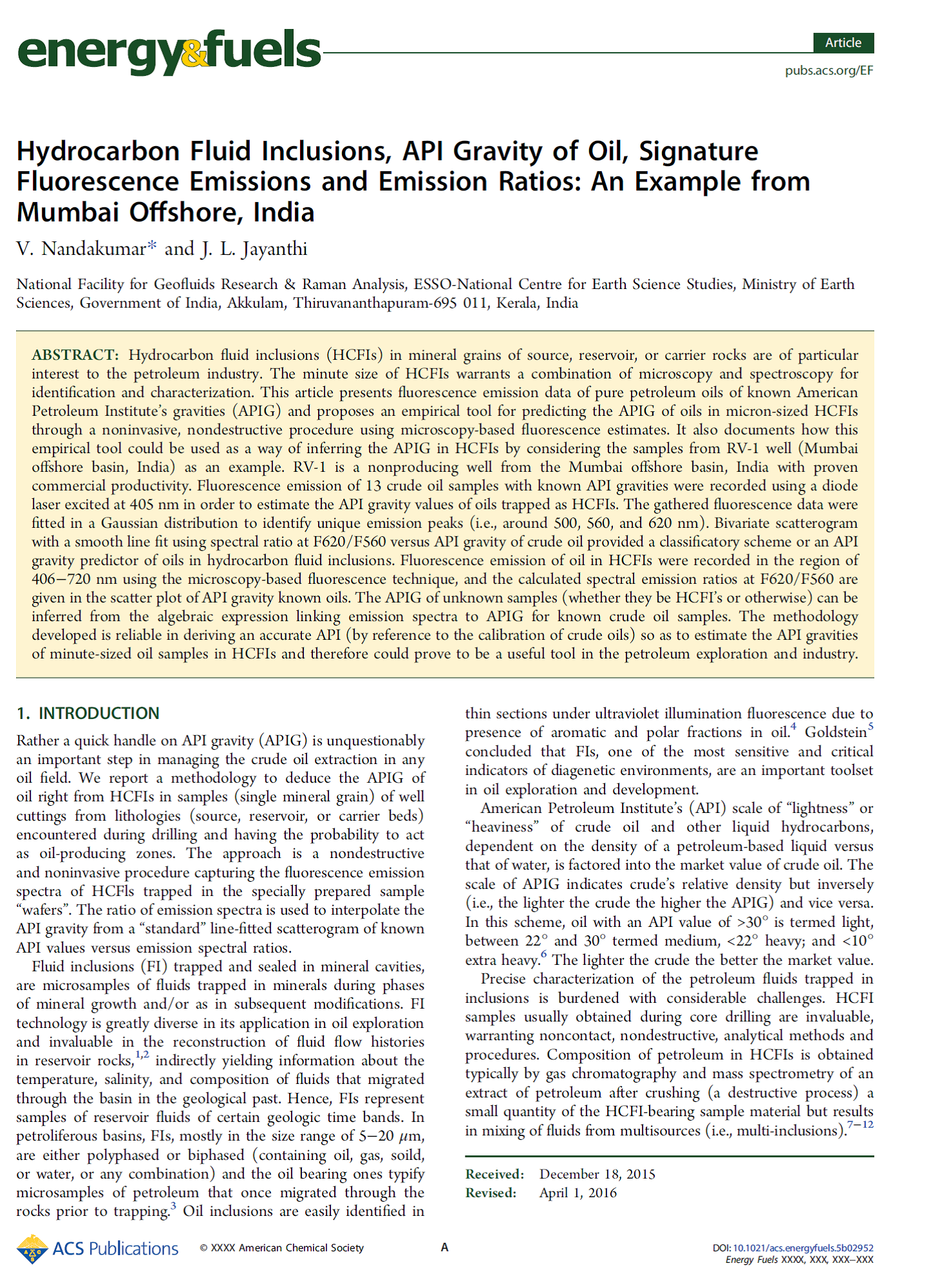Research Updates
 A methodology was invented to detect the unknown API gravity of oils/oils in HCFIs/oil condensates using fluid inclusion techniques coupled with microscope-based fluorescence emission spectroscopy. The API gravity (American Petroleum Institute’s gravity) is a commercial value indicator of petroleum (HCFIs). A diode laser emitting at 405 nm was used for the study. We have derived an arithmetic equation y = y0 (x0−x)t ± 1 for determining the unknown API gravity based on fluorescence emission ratio at F620/F560. With the use of a laser as an excitation source it is possible to specifically target the fluorophores that have absorption at this wavelength within the HCFIs. The precise determination of API gravity of oils in HCFIs at the time of drilling itself leads to the estimation of the quality of oils in a basin that gives an impetus for further exploration activities in petroleum industry. In general, 40% of the exploratory wells may end up as a dry well and the patented invention can help to determine the quality of minute quantities of oil detected by means of fluid inclusion studies and determination of API gravity values using a non-destructive micro-spectrometric technique could lead to further exploration in adjoining areas areas of such dry & abandoned wells...
A methodology was invented to detect the unknown API gravity of oils/oils in HCFIs/oil condensates using fluid inclusion techniques coupled with microscope-based fluorescence emission spectroscopy. The API gravity (American Petroleum Institute’s gravity) is a commercial value indicator of petroleum (HCFIs). A diode laser emitting at 405 nm was used for the study. We have derived an arithmetic equation y = y0 (x0−x)t ± 1 for determining the unknown API gravity based on fluorescence emission ratio at F620/F560. With the use of a laser as an excitation source it is possible to specifically target the fluorophores that have absorption at this wavelength within the HCFIs. The precise determination of API gravity of oils in HCFIs at the time of drilling itself leads to the estimation of the quality of oils in a basin that gives an impetus for further exploration activities in petroleum industry. In general, 40% of the exploratory wells may end up as a dry well and the patented invention can help to determine the quality of minute quantities of oil detected by means of fluid inclusion studies and determination of API gravity values using a non-destructive micro-spectrometric technique could lead to further exploration in adjoining areas areas of such dry & abandoned wells...
Patentee Info: Dr. V. Nandakumar, Dr. J. L. Jayanthi
National Centre for Earth Science Studies
Patent No. 315456 dated 03/07/2019
 The challenge with Raman spectral studies on natural hydrocarbon-bearing fluid inclusions (HCFIs) is the common presence of fluorescence emission from minerals and aromatic compounds in HCFIs leading to the masking of Raman signals. Selection of optimum excitation wavelength is another challenge. To overcome these hurdles, special wafer preparation techniques, along with the use of fluorescence quenchers, were employed in our study to obtain Raman signals from natural HCFIs. The present study is a demonstration of how best the Raman signals from natural hydrocarbon-bearing fluid inclusions could be detected using an excitation wavelength of 785 nm with suitable optical parameters and with special wafer preparation techniques to negate the background fluorescence. Using the laser Raman technique we were able to detect peaks corresponding to cyclohexane, benzene and bromobenzene, carbon monoxide, nitrogen, ethylene, sulphur oxide, carbonyl sulphide, hydrogen sulphide in liquid form along with the presence of a broad peak of liquid water, peaks of calcium carbonate and calcium sulphate. The chemical constituents in natural HCFIs from the same basin identified using laser Raman spectrometric methods with a 785 nm laser excitation agrees well with the GC-MS results of oil in the same basin, which again supports the utility of the laser Raman technique with 785 nm laser for the chemical constituents identification in natural HCFIs. The present study elucidates the potential of Raman spectroscopic methods using a 785 nm laser excitation for detecting the chemical constituents of HCFIs..
The challenge with Raman spectral studies on natural hydrocarbon-bearing fluid inclusions (HCFIs) is the common presence of fluorescence emission from minerals and aromatic compounds in HCFIs leading to the masking of Raman signals. Selection of optimum excitation wavelength is another challenge. To overcome these hurdles, special wafer preparation techniques, along with the use of fluorescence quenchers, were employed in our study to obtain Raman signals from natural HCFIs. The present study is a demonstration of how best the Raman signals from natural hydrocarbon-bearing fluid inclusions could be detected using an excitation wavelength of 785 nm with suitable optical parameters and with special wafer preparation techniques to negate the background fluorescence. Using the laser Raman technique we were able to detect peaks corresponding to cyclohexane, benzene and bromobenzene, carbon monoxide, nitrogen, ethylene, sulphur oxide, carbonyl sulphide, hydrogen sulphide in liquid form along with the presence of a broad peak of liquid water, peaks of calcium carbonate and calcium sulphate. The chemical constituents in natural HCFIs from the same basin identified using laser Raman spectrometric methods with a 785 nm laser excitation agrees well with the GC-MS results of oil in the same basin, which again supports the utility of the laser Raman technique with 785 nm laser for the chemical constituents identification in natural HCFIs. The present study elucidates the potential of Raman spectroscopic methods using a 785 nm laser excitation for detecting the chemical constituents of HCFIs..
Bibliographic Info: JL Jayanthi, V. Nandakumar and S. S. Anoop [2017]. Feasibility of a 785 nm diode laser in Raman spectroscopy for characterizing hydrocarbon-bearing fluid inclusions in Mumbai Offshore Basin, India. Petroleum Geoscience, 23 (3), 2017, 369-375. doi: https://doi.org/10.1144/petgeo2016-071
 The charnockite suites of rocks possess greater significance in addressing the processes operating at lower continental crust and, thereby, provide ample evidence to decipher the petro-tectonic evolution of the Earth’s crust. The new research findings of Ravindra Kumar and Sreejith, published in ‘Lithos’ provide a comprehensive understanding on the lower crustal processes leading to protolith diversification on the genesis of different charnockite suites of southern India. The study distinguishes three different suites of charnockites, viz., tonalitic, granitic, and augen suites based on their petrological and geochemical attributes. Further, the study envisages four-stage magmatic crustal evolution model for the Kerala Khondalite Belt (KKB), spanning from Meso- to Neoarchaean up to Mesoproterozoic. The authors propose that the onset of juvenile magmatism in the KKB was initiated by the formation of Meso- to Neoarchaean basaltic crust in an oceanic lithosphere, which underwent melting due to basaltic underplating leading to the formation of TTGs. Subsequent intra-crustal melting during a stage of arc accretion initiated differentiation of the TTG crust into tonalitic and granitic magmas during Palaeoproterozoic. The fourth stage of crustal evolution is correlated with the Mesoproterozoic emplacement of megacrystic K-feldspar granites. This novel research contribution offers an insight into the long ignored aspect of origin and evolution of orthopyroxene-bearing, felsic ortho-granulites (charnockite) of KKB and their geodynamic setting. The study also establishes fairly–well correlation between the magmatic episodes of KKB and prominent crustal growth events recorded globally. The full-article can be read online at “Lithos” journal website hosted by SciVerse ScienceDirect.
The charnockite suites of rocks possess greater significance in addressing the processes operating at lower continental crust and, thereby, provide ample evidence to decipher the petro-tectonic evolution of the Earth’s crust. The new research findings of Ravindra Kumar and Sreejith, published in ‘Lithos’ provide a comprehensive understanding on the lower crustal processes leading to protolith diversification on the genesis of different charnockite suites of southern India. The study distinguishes three different suites of charnockites, viz., tonalitic, granitic, and augen suites based on their petrological and geochemical attributes. Further, the study envisages four-stage magmatic crustal evolution model for the Kerala Khondalite Belt (KKB), spanning from Meso- to Neoarchaean up to Mesoproterozoic. The authors propose that the onset of juvenile magmatism in the KKB was initiated by the formation of Meso- to Neoarchaean basaltic crust in an oceanic lithosphere, which underwent melting due to basaltic underplating leading to the formation of TTGs. Subsequent intra-crustal melting during a stage of arc accretion initiated differentiation of the TTG crust into tonalitic and granitic magmas during Palaeoproterozoic. The fourth stage of crustal evolution is correlated with the Mesoproterozoic emplacement of megacrystic K-feldspar granites. This novel research contribution offers an insight into the long ignored aspect of origin and evolution of orthopyroxene-bearing, felsic ortho-granulites (charnockite) of KKB and their geodynamic setting. The study also establishes fairly–well correlation between the magmatic episodes of KKB and prominent crustal growth events recorded globally. The full-article can be read online at “Lithos” journal website hosted by SciVerse ScienceDirect.
Bibliographic Info: Ravindra Kumar, G.R. and Sreejith, C., 2016. Petrology and geochemistry of charnockites (felsic ortho-granulites) from the Kerala Khondalite Belt, Southern India: Evidence for intra-crustal melting, magmatic differentiation and episodic crustal growth. Lithos, vol. 262, pp. 334-354. doi: 10.1016/j.lithos.2016.07.009
 In-situ zircon U-Pb isotopic ages obtained on a garnet + cordierite bearing leucosome in migmatitic paragneiss at Kanjampara in the Trivandrum Block, demonstrate zircon crystallisation from melt at 1.92 ± 0.04 Ga. The unique trace element chemistry of the zircon, including high U/Yb, low Th/U, and flat MREE-HREE patterns with pronounced negative Eu anomalies, coupled with the presence of inclusions of sillimanite, apatite, quartz, feldspar and rare biotite in the zircon, confirms its formation as a result of anatexis associated with a high-T metamorphism at 1.92 Ga. This conclusion is supported by the local preservation of Palaeoproterozoic chemical age domains (820-860ºC. The strongly REE-P zoned garnet present in the Kanjampara leucosome, which is demonstrated to not be in HREE or Eu equilibrium with the 1.92 Ga zircon, formed as a result of anatexis and melt interaction during this Neoproterozoic-Cambrian tectonothermal event. Th-U-Pb chemical age data indicates that monazite was either formed or extensively recrystallized at during this anatexis at 565 ± 6 Ma, undergoing further modification to form high-Th cuspate rims at 517 ± 15 Ma. The age of the final monazite chemical modification is equivalent to the lower intercept age of 528 ± 18 Ma for extensive Pb-loss from the highly discordant but otherwise well-preserved Palaeoproterozoic (1.92 Ga) zircon. The growth or recrystallisation of monazite at ca. 565 Ma and its further modification at ca. 520 Ma indicates that the high-T metamorphism in the Pan-African was long-lived, with a duration of at least 45 Myr. The new age-event results from Kanjampara confirm that at least some of the metasedimentary paragneisses in the Trivandrum Block are polymetamorphic, initially metamorphosed in the Palaeoproterozoic in an event older than the 1.89-1.85 Ga granitic orthogneisses recognised from the region.
In-situ zircon U-Pb isotopic ages obtained on a garnet + cordierite bearing leucosome in migmatitic paragneiss at Kanjampara in the Trivandrum Block, demonstrate zircon crystallisation from melt at 1.92 ± 0.04 Ga. The unique trace element chemistry of the zircon, including high U/Yb, low Th/U, and flat MREE-HREE patterns with pronounced negative Eu anomalies, coupled with the presence of inclusions of sillimanite, apatite, quartz, feldspar and rare biotite in the zircon, confirms its formation as a result of anatexis associated with a high-T metamorphism at 1.92 Ga. This conclusion is supported by the local preservation of Palaeoproterozoic chemical age domains (820-860ºC. The strongly REE-P zoned garnet present in the Kanjampara leucosome, which is demonstrated to not be in HREE or Eu equilibrium with the 1.92 Ga zircon, formed as a result of anatexis and melt interaction during this Neoproterozoic-Cambrian tectonothermal event. Th-U-Pb chemical age data indicates that monazite was either formed or extensively recrystallized at during this anatexis at 565 ± 6 Ma, undergoing further modification to form high-Th cuspate rims at 517 ± 15 Ma. The age of the final monazite chemical modification is equivalent to the lower intercept age of 528 ± 18 Ma for extensive Pb-loss from the highly discordant but otherwise well-preserved Palaeoproterozoic (1.92 Ga) zircon. The growth or recrystallisation of monazite at ca. 565 Ma and its further modification at ca. 520 Ma indicates that the high-T metamorphism in the Pan-African was long-lived, with a duration of at least 45 Myr. The new age-event results from Kanjampara confirm that at least some of the metasedimentary paragneisses in the Trivandrum Block are polymetamorphic, initially metamorphosed in the Palaeoproterozoic in an event older than the 1.89-1.85 Ga granitic orthogneisses recognised from the region.
 Fluid inclusions (FIs) are microsamples of fluids trapped in minerals during mineral growth and/or as in subsequent modifications. FI technology is greatly diverse in its application in oil exploration and invaluable in the reconstruction of fluid flow histories in reservoir rocks, indirectly yielding information about the temperature, salinity, and composition of fluids that migrated through the basin in the geological past. Hence, FIs represent samples of reservoir fluids of certain geologic time bands. In petroliferous basins, FIs, mostly in the size range of 5−20 μm, are either polyphased or biphased (containing oil, gas, soild, or water, or any combination) and the oil-bearing ones typify microsamples of petroleum that once migrated through the rocks prior to trapping. Hydrocarbon fluid inclusions (HCFIs)/oil inclusions in mineral grains of source, reservoir, or carrier rocks are of particular interest to the petroleum industry. Determination of the American Petroleum Institute’s gravity (APIG, density of oil factored into the market value of crude oil) of oils in HCFIs is important since it offers unique insight into the quality of oils that are present in the different formations of petroliferous basins. We have identified that the scattergram of emission ratio (F620/F560) of crude oils versus API gravity is an accurate graphical tool to predict or determine the API gravity of oils in HCFIs. The APIG of unknown samples (whether they be HCFIs or bulk oils) that can be inferred from the derived algebraic expression linking emission spectra to APIG for known crude oil samples i.e., y = y0 (x0 − x)t ± 1 where y0, x0, and t are constants with values, y0 = 23, x0 = 2.55, and t = 1.4, and x is the emission ratio value at F620/F560. The study highlights the measuring of the fluorescence emission of the HCFIs as a valuable signature for quick detection of APIG.
Fluid inclusions (FIs) are microsamples of fluids trapped in minerals during mineral growth and/or as in subsequent modifications. FI technology is greatly diverse in its application in oil exploration and invaluable in the reconstruction of fluid flow histories in reservoir rocks, indirectly yielding information about the temperature, salinity, and composition of fluids that migrated through the basin in the geological past. Hence, FIs represent samples of reservoir fluids of certain geologic time bands. In petroliferous basins, FIs, mostly in the size range of 5−20 μm, are either polyphased or biphased (containing oil, gas, soild, or water, or any combination) and the oil-bearing ones typify microsamples of petroleum that once migrated through the rocks prior to trapping. Hydrocarbon fluid inclusions (HCFIs)/oil inclusions in mineral grains of source, reservoir, or carrier rocks are of particular interest to the petroleum industry. Determination of the American Petroleum Institute’s gravity (APIG, density of oil factored into the market value of crude oil) of oils in HCFIs is important since it offers unique insight into the quality of oils that are present in the different formations of petroliferous basins. We have identified that the scattergram of emission ratio (F620/F560) of crude oils versus API gravity is an accurate graphical tool to predict or determine the API gravity of oils in HCFIs. The APIG of unknown samples (whether they be HCFIs or bulk oils) that can be inferred from the derived algebraic expression linking emission spectra to APIG for known crude oil samples i.e., y = y0 (x0 − x)t ± 1 where y0, x0, and t are constants with values, y0 = 23, x0 = 2.55, and t = 1.4, and x is the emission ratio value at F620/F560. The study highlights the measuring of the fluorescence emission of the HCFIs as a valuable signature for quick detection of APIG.




 RTI Act
RTI Act
